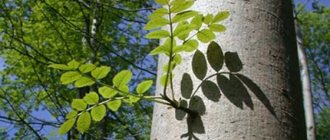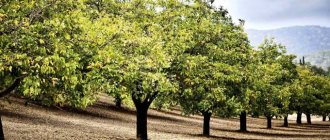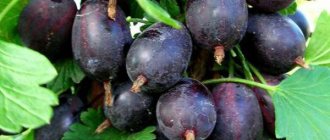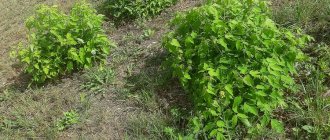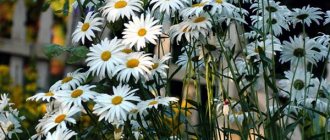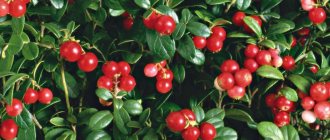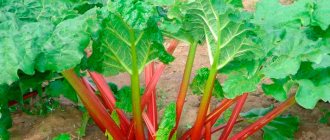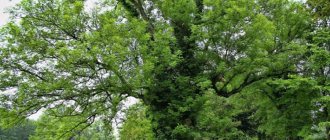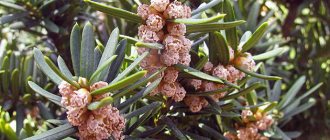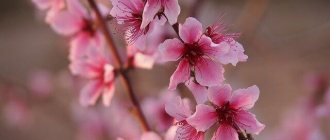Ash: description
Common ash belongs to the Olive family. This is a tree that has a height of up to 30 m, a trunk diameter of up to 1 m. The crown is highly raised, openwork, the bark is painted gray and covered with numerous “cracks”. Ash leaves are bright green, lanceolate or oblong-ovate.
The average lifespan is about 300 years, but few trees survive to this age due to diseases and pests.
The fruit of an ash tree is a “lionfish” with a seed inside. In nature, the tree reproduces by both seeds and layering.
The widespread use of ash for landscaping cities and parks is due to its unpretentiousness and the structural characteristics of the wood. Ash wood is resistant to cracking, flexible, and has high strength, so in the event of strong storm winds and heavy snowfalls, the tree branches will withstand the onslaught of bad weather.
Thus, according to its description and characteristics, the ash tree is suitable for the role of the main accent in the garden. It can be used as a dividing element for a site, or as a “living fence” to protect against noise and dust if it is planted near the roadway.
Types of ash
There are more than 60 varieties of ash. Each has its own distinctive features. The most common ones are the following.
- Common ash. Its leaves have characteristic carved edges. The height can reach more than 30 m. The trunk of a young tree is covered with gray-green bark, which with age becomes covered with cracks and acquires a dark gray color. The buds are black with small specks. Flowering occurs in March, the inflorescences appear earlier than the leaves. The common ash tree lives for a very long time - more than 300 years. Common ash wood is a valuable raw material for the wood processing industry.
- American ash. Its leaves are distinguished by the fact that they are darker below than above. The shape is similar to the foliage of a walnut, but the ends are sharper and wedge-shaped. It blooms early, with buds appearing by early April. Doesn't like drought.
- Black ash. It has dark, thick bark. This tree never blooms. Morozov is not afraid.
- White ash. It is also called semolina. The height of the tree is up to 20 m. The crown is often round or ovoid. When branches are cut, manna comes out - sap that solidifies in the air. This is the reason why white ash is used in the pharmaceutical industry. White ash blooms with beautiful white panicle inflorescences. Due to its beauty, this tree is used as an ornamental plant for parks, gardens, etc.
- Narrow-leaved ash. The name comes from the shape of the foliage. It tolerates frost easily and begins to bloom in May-June. The height can reach about 20 m. It grows as a bush or as an ordinary tree.
- Manchurian ash. The leaves are distinguished by carved edges, the trunk is straight and slender, the crown is raised high. The branches are located obliquely. Blooms from late spring to early autumn. Often found in Russia.
- Lanceolate ash. This tree is not tall compared to other varieties: it rarely reaches 15 m in height. The buds are brick-brown and have down. Loves light, is not afraid of frost and drought.
- Fluffy ash. The reason for this name is the light fluff that covers the young shoots.
- Ball-shaped ash Nana. It is distinguished by its slow growth, small height: 7 – 8 m. Resembles a shrub. Resistant to low temperatures.
- Chinese ash (Ailanthus). A beautiful tree that resembles a palm tree due to its long (sometimes up to 50 cm) leaves. It grows very quickly: it can grow 1 m in a year. It blooms with large greenish-yellow panicle inflorescences. Flowering begins closer to the second half of summer.
What does ash like, where is the best place to plant a tree?
Having learned about what ash looks like, we move on to choosing a place for planting.
The tree is resistant not only to strong gusts of wind, but also to smoke or gas. Therefore, a plant planted near the roadway will not get sick or grow poorly. Ash is very popular in the temperate zone, as it can withstand frosts down to -40 °C. To make the ash tree feel comfortable, it needs to be planted in a sunny place.
It is demanding not only of light, but also of soil fertility. The tree will not grow on sandy or other infertile soils.
Ash does not tolerate stagnation of moisture in the soil or excessive salinity, so for planting you should choose slightly acidic soils at higher elevations or places where groundwater is low.
Planting an ash tree
Now let's talk about how to plant an ash tree. The tree reproduces both generatively and vegetatively. The only difference is that it is much easier to buy an ash seedling than to find good germinating seeds.
Features of growing ash from seeds
For sowing in summer, last year's seeds are used, but freshly harvested ones can be planted at the end of August, if the climate permits.
Seeds are sown in furrows, deepening the planting material 3-5 cm into the soil. On average, about 8 g of seeds are taken per 1 meter of furrow. If you are carrying out large-scale planting, then at least 240 kg of planting material is used to sow 1 hectare.
The first shoots appear in May. Crops require care, which consists of weeding, regular watering and minimal (4-6 times per summer) loosening of the soil.
Growing ash from seeds requires a lot of time and resources, which is only justified in the case of “large-scale” plantings. If you want to plant 1-2 trees, then it is better to buy a seedling from a nursery or market.
Technology of planting ash seedlings
Growing an ash tree from a seedling is much easier than planting seeds. To begin, prepare a hole that should be 1/3 larger than the earthen ball on the rhizome. Drainage (pebbles, expanded clay or small crushed stone) should be laid at the bottom of the pit, which should be 25% of the total height of the pit.
After preparing the hole, it must be filled with a nutrient soil mixture, which consists of leaf soil, humus and river sand in a ratio of 1:2:1.
An important point: during planting, the rhizome should be 10-15 cm above the ground so that after the soil settles, the root collar does not go deep into the ground.
Before planting, moisten the hole well with water and place supports to which the seedling will be attached.
We recommend mulching the tree trunk with peat or sawdust to retain moisture in the soil and protect the young tree from sudden hypothermia or overheating of the root system.
When planting several ash seedlings, maintain a safe distance, which is 5 m for tall trees and 3-3.5 m for dwarf trees.
Where does the tree grow
This plant is often used to decorate the landscape because it looks spectacular in summer and winter. This plant is widespread throughout our country, including being planted in gardens. Typically, gardeners tend to purchase seedlings from nurseries. It is more difficult to grow an adult tree from seeds. People are especially attracted to the sight of ash trees in autumn.
Many species of this plant grow under natural conditions. Depending on the variety, the growing area also changes.
Ash can be seen in the middle zone, in the southern regions, in European countries. According to legends and myths, you can read that the tree grew in the territory of Rome and in the Scandinavian countries. The tree also grew in America, but was not as widespread. Migrant settlers from Europe took planting material with them from here and, on the contrary, brought their own seeds.
Popular: Planting three types of coniferous trees to decorate a site
In Russia, this tree can often be found in the forest, but recently it has often been planted in alleys, parks, at the entrances to houses, and on memorial complexes.
The nuances of growing ash: how to care for the plant
Knowing where and under what conditions ash grows, you need to create a similar microclimate in your dacha so that the tree receives everything it needs and has stable immunity to disease.
Watering an ash tree
Ash requires abundant watering, but the amount of moisture you add to the soil must correspond to the drainage properties of the substrate. That is, if the ground cannot absorb more moisture, then there is no need to flood the tree “according to the instructions.”
Ash trees should only be watered during severe drought. However, it is worth remembering that plants should not be watered in strong winds or in hot sun.
Feeding options for ash, how to fertilize the plant
Gardeners are justifiably interested in the question of how to care for an ash tree so that the tree does not get sick and is not damaged by “typical” pests.
Like a person, a tree has its own immunity, and in order for it to be strong, the plant needs a variety of feedings and fertilizers. Since the nutritious soil mixture that you laid when planting the seedling will last for a maximum of 2 years, in the future the ash tree needs to be fed in spring and autumn.
In the spring, add 2 kg of manure, 15 g of urea and 25 g of calcium and ammonium nitrate per 20 liters of water. That is, we fertilize the tree with nitrogen-containing fertilizers.
In autumn, the tree is topped with nitroammophoska (20 g per 20 liters of water).
It is worth remembering that depending on the fertility of the soil, the amount of fertilizer may be more or less. Therefore, listen to our advice and use your knowledge.
What is important to know when pruning ash trees
Ash pruning is carried out in the spring, before flowering begins. Dry, frozen and diseased branches are removed. Pruning also helps to form the crown of the desired shape.
You should start by removing the lower shoots. The stem is cleared to a height of 3 m.
Next, all thin and fragile shoots are removed, which in the future will not be able to withstand the weight of the leaves. It is worth remembering that the tree is prone to growing watery shoots on the lower part of the trunk, which must be removed immediately.
Rules of care
When planted in fertile soil, the plant will grow very quickly, increasing by 34-45 cm per year. Due to the fact that the young plant forms new branches very quickly, it needs formative pruning of the crown. It is better to do this before flowering begins, that is, in the spring. But you don’t need to be too zealous with pruning, otherwise the procedure will negatively affect the condition of the tree.
Preparing trees for wintering is necessary only in the first 2-3 years. Mature plants usually cope with frosts easily. It is noteworthy that there are varieties of ash that can withstand cold temperatures down to -42 degrees.
Diseases and pests of ash
Diseases in ash trees occur both due to improper watering and lack of fertilizing, as well as due to strong temperature changes, contamination of the area with rotten residues and insect vectors.
Cytophomal cancer. A fungal disease that affects the bark and sapwood of a tree. The disease occurs in ash trees aged 10 years or more. The tree suffers from temperature imbalance and does not tolerate extreme heat or frost. When severely damaged by cancer, the tree dries out.
Measures to combat the disease: sanitary cutting down of diseased trees, increased watering of plants.
Infectious necrosis. A fungal disease characterized by banding, bark and cambium death.
Control measures: spring spraying of trees with a 3% solution of iron sulfate, spraying during the growing season with a 1% solution of Bordeaux mixture, sanitary measures and fertilizing of trees.
White finely cracked butt rot. A terrible fungal disease of ash that affects the central part of the trunk and in some cases the roots. The fungus attacks old trees whose bark has holes or cracks. At the final stage, the ash wood simply falls apart and the tree dries out. It is almost impossible to identify this disease, since this requires cutting down the tree.
Article on the topic: Willow wintergreen description and features
Control measures: sanitary felling, covering cracks in bark and wood with clay or special protective mixtures.
All parasites that harm ash trees settle in the bark, bast or wood, so it is very difficult to identify them immediately.
Variegated ash beetle. Dangerous pest of ash tree trunks and branches. The pine beetle is similar in appearance to the cockchafer, grows up to 3 mm, and is brown in color. The beetle appears in late April – early May. It affects weakened trees or fresh fellings. Females lay larvae in the sapwood, which turn into adults in June. If a tree is severely affected by a beetle, then this threatens inevitable “death.” The pine beetle is so dangerous that it can destroy a large ash planting in a season, turning young trees into eaten dead wood.
Control measures: treatment of plantings with insecticides during the beginning of the beetle’s flight (“Ampligo 150”, “Enzhio 247”, “Karate Zeon 050”); attracting birds that feed on beetles (installing feeders); laying out trap trees in February-March.
Emerald ash borer. An insect from the order Coleoptera, which in nature is widely distributed in China, Korea and Japan. The borer is painted marsh green and is about 1 cm long. Females lay eggs on the surface of the bark, after which the larvae penetrate into the phloem. You can notice the activity of the larvae after removing the bark: small passages along which the larvae move under the bark will be visible on the surface of the wood. Beetles, unlike larvae, do not feed on ash bast, but on its leaves, causing serious damage to the tree.
Symptoms of infection: sparse bark, sickly appearance of the tree, premature yellowing of leaves.
Control measures: tampons moistened with a hexachlorane suspension (100 g per 1 liter of water) are inserted into the fresh passages of the larvae, after which the holes are covered with clay or cement; spraying the plantings with a 3% chlorophos solution in late May - early June.
To prevent trees from getting sick or being affected by pests, try to carry out inspections more often, cover up cracks in the bark and phloem, and carry out sanitary felling of sick and dry trees in the garden. Remember that many diseases and pests appear in dirty gardens where plant debris has not been removed for years. Don't give parasites and diseases an extra chance, and your plants will always look healthy.
Ash varieties
Depending on natural conditions, types of ash trees may vary. Tall, Manchurian, curved-fruited ash grows on the territory of our country.
Ordinary
Growing area: Western and Central Europe, in the temperate climate zone of Russia. It is possible to find tall ash trees in Iran or the Caucasus. It usually grows in the forest, but can be planted in city parks and squares. It can grow up to 30–40 meters, and its leaf reaches forty centimeters and consists of several leaf plates. Flowers bloom on the tree in April before the leaves come out.
American
It can be found in eastern North America. It differs from the ordinary type of tree in having an expanded leaf and a short plate. The edge of the leaf is framed with teeth. The tree has a wide crown with light green leaves. The trunk has a lighter bark with a silvery tint.
Downy (Pennsylvania) Ash
This culture is not afraid of cold and prefers a large amount of moisture. The tree does not grow as tall as the others. Its average height reaches 20 meters. Fluffy ash prefers to grow in a brightly lit area; it does not tolerate shade. In a shaded area, the plant quickly dies. Its young branches are framed with down, the back side of the leaf blade is also pubescent. Leaf color: dark green. The trunk has brown-brown bark. This plant is long-lived. It lives up to 350 years.
Manchurian ash
Under natural conditions, it grows in eastern Russia, China, and Japan. This is a tall plant, reaching a height of 40 meters and a trunk girth of up to two meters. Chinese ash is distinguished by its large leaf blades. It has a thick grey-green bark.
Black
Feature of the variety: does not bloom. Black ash grows in the United States, in swamps and near water bodies. The trunk has almost black bark. This culture loves moisture very much and suffers from its deficiency.
"I asked ash…"
The ancient Greek gods believed that ash wood could be quite a suitable material for creating a person. And in Hesiod’s poem “Works and Days” it is said that Zeus created people from the shaft of a spear, which, as is known, ancient Greek gunsmiths carved from ash wood. The warlike spirit that the ash tree absorbed was passed on to the people created from it. In Ancient Greece, ash was considered a symbol of fair retribution, which is probably why the punishing Nemesis, the goddess of retribution, was often depicted by artists with an ash branch in her hand .
Some peoples had a belief that poisonous snakes were afraid of ash, especially its sap, like fire. It was believed that it was enough to wet, for example, a shirt with juice, and then, after drying it well, put it on to protect yourself from snake bites. For a person wearing such a shirt, the snake becomes safe and even allows him to control himself.
Ash was one of the revered trees in the Caucasus. From generation to generation, mountaineers protected not only individual “sacred” trees, but also entire ash groves . Under their shade the mountaineers performed sacrifice rituals. The peaceful spirit of the Caucasian ash tree did not require bloody sacrifices and was completely satisfied with a wide variety of dairy products brought to its feet.
All parts of the tree, from the buds to the roots, were used by people in the household and everyday life. Before the start of sap flow, Caucasian mountaineers collected buds and bark from young branches in early spring, and later leaves. Decoctions of the bark and buds were used as a rub for rheumatism and aches. Patients with fever were treated with decoctions of leaves and bark . Beekeepers made quite spacious hives from the bark of large ash trees. During sap flow, the bark was removed in wide layers. Then they were sewn together with thin bark, cut into narrow strips. A cone-shaped lid made of thick ash bark was fitted on top of the resulting cylinder.
© Carly & Art
Ash (lat. Fraxinus) is a genus of woody plants from the Olive family (Oleaceae).
The genus includes more than 50 species growing in temperate latitudes of the Northern Hemisphere.
These are powerful deciduous trees, up to 30 m tall, with a broadly rounded, light crown, on highly raised grayish or grayish-green branches. The leaves are opposite, imparipinnate, bloom much later than those of other deciduous species, and fall early. The flowers are undecorative, arranged in bunches or panicles at the ends of shortened shoots. They bloom before the leaves bloom. The fruits are winged achenes or nuts.
Light-loving, develop better in rich, fairly moist soils with sufficient calcium content. Smoke and gas resistant. They do not tolerate pruning well. They grow quickly. They reproduce by sowing seeds.
© dichohecho
Growing
Planting Features: Prefers a sunny place, rich in organic matter, fairly moist soil with sufficient calcium content. Does not tolerate soil salinity and stagnant water. Tolerates drought.
The distance between plants when planting is at least 5 m. As a rule, after planting, subsidence and compaction of the soil occurs, so the root ball should be 10-20 cm above ground level when planting. This is especially true for large-sized ones. Before planting, the root system must be thoroughly saturated with moisture.
Soil mixture: leaf soil, humus, sand (1:2:1).
Drainage – crushed stone or sand – 15 cm.
Mulch - peat, wood chips 8-15 cm.
Acidity pH 6-7.
Feeding: In early spring and late spring, fertilizing with nitrogen-containing fertilizers (mullein - 1 kg, urea - 10 g, ammonium nitrate - 20 g per 1 bucket of water). In the fall, feed with kemira-universal or nitroammophoska - 20g per 1 bucket of water.
Watering: Mandatory during planting and the next 3-4 days. During dry periods, additional watering is required: 1 bucket/1 sq.m. crown projections, although it tolerates short-term drought well.
Loosening: When weeding, 5-7 cm.
Haircut, pruning: Ash does not tolerate pruning well, so it is recommended only to cut out drying branches and clean the trunk of sprouts.
Diseases and pests:
- 1. Ash spandex. Kinmiks, decis, warbofos, twice.
- 2. Ash beetle. Karbofos, twice.
- 3. Cancer of trunks and branches. Cutting out cancerous ulcers, followed by treatment with an antiseptic and putty with garden pitch.
Preparation for winter: For standard plants, the standard is wrapped in burlap for the first 2-3 years.
© dichohecho
American ash - Fraxinus americana.
East of North America. In deciduous forests on deep, rich, moist, well-drained soils near watercourses and on the slopes of hills and mountains, up to 1050 m above sea level. seas.
A powerful dioecious tree, up to 35 m tall, with a broadly ovate crown, bare young shoots and light brown buds. The leaves are compound, odd-pinnate, of 7 (5-9) leaflets, ovate, entire or serrated, glabrous, dark green above, glaucous below, up to 12 cm long. It grows quickly, is relatively drought-resistant and more frost-resistant than common ash, and is not damaged by spring frosts, since the buds bloom 8-10 days later than other ash trees. Tolerates city conditions well and is durable. Propagated by sowing stratified seeds. Thanks to its fast growth, beautiful openwork crown and durability, it is a valuable plant for alley, group and composition plantings. In culture since 1874.
White or flower ash - Fraxinus ornus.
European part of Russia, Western Europe, Middle East. Not listed in the flora of the reserves. Light-loving xero-mesophyte of deciduous forests.
A small tree, up to 12 m tall, with a regular, round, dense crown. The leaves are light green, consisting of 7 oblong-ovate, irregularly toothed leaflets up to 9 cm long, pubescent below along the midrib. It differs from other species of the genus in its white, fragrant flowers, with long, narrow petals, collected at the ends of the shoots into lush, dense panicles up to 15 cm long. During flowering, which lasts 7-10 days, it is very decorative.
Article on the topic: Virginia bird cherry description and features
It is characterized by great photophilia and drought resistance. It grows relatively slowly. Not frost-resistant enough. Recommended for single, group and alley plantings in the south of Russia. In culture before 1700.
Lanceolate or green ash -Fraxinus lanceolata.
It is found naturally in the eastern part of North America, from where it was introduced into culture in the 18th century and spread widely. In deciduous forests (sometimes forms pure stands), along the banks of watercourses, on damp hills.
Very decorative with a slender trunk, compact crown and shiny, dark green leaves, pale green below. Reaches 15 m in height. It is distinguished by fairly fast growth and high drought resistance. Less demanding on soil than other species, more stable in urban environments. Frost-resistant. It is successfully growing in Moscow and St. Petersburg.
Common ash - Fraxinus excelsior.
Distributed in the European part of Russia (does not reach the Volga), in the forests of the mountainous Crimea and the Caucasus, throughout Western Europe, the Mediterranean and Asia Minor. Available in many nature reserves. In deciduous forests on fertile carbonate soils, light-loving mesophyte.
The most famous representative of the genus. Tree up to 30 m tall, with a broadly oval, openwork crown, with straight, slightly branched branches and odd-pinnate foliage. The trunk bark is initially ash-gray, almost smooth, later with deep, longitudinal and small transverse cracks. Young shoots are bare, greenish-gray. The buds are black with velvety pubescence, very impressive against the background of bare branches. The leaves are imparipinnate, of 7-9 sessile, broadly lanceolate, serrate along the edge, with bright green leaflets above, green below, hairy along the veins. Flowers without perianth, inconspicuous. The fruits are lionfish, up to 5 cm long, often stored on the branches all winter.
Grows quickly, light-loving. In adulthood, it tolerates temperatures down to -40°C. In harsh winters, some of the shoots may freeze, so it is better to plant it in protected places. It also suffers from late spring frosts, but then quickly recovers. It tolerates air dryness well, but worse tolerates soil dryness. It is demanding on soil and is not sufficiently smoke and gas resistant. It is propagated by seeds, which germinate without stratification only in the second year. Decorative forms are propagated by grafting onto the main species. Lives up to 300 years.
A valuable tree for green construction due to its fast growth, powerful size, slender trunk and openwork crown. Looks good in alley plantings, complex compositions, and road lining.
It has many forms used in gardening construction. The most interesting of them are the following: monumental (very impressive, strong growth, with a pyramidal crown; low (slow growing, with a compact spherical crown; weeping - a tree up to 8 m tall, with a dome-shaped crown and long branches hanging to the ground, very impressive in a single planting; horizontal - with horizontally spread main branches, a wide, flat crown and weeping branches; curly - with small, curly, dark green leaves; finely cut - with very narrow, slightly jagged leaves; variegated - a large tree with simple, single or partially trifoliate leaves, looks very peculiar in a single planting; yellow-leaved - with yellow leaves; golden - with yellow shoots and smaller leaves; golden-variegated; golden weeping; silver-variegated; variegated - on young shoots the bark has pink-white stripes that They greatly decorate a tree in its leafless state.
Argenteo-variegata. Light, almost white wood, smaller in size than the original form. The leaves are edged with an uneven silvery-white stripe, and in some places they are completely white. Ash has a very elegant look. The white stripe along the edge of the leaf sometimes turns light brown and the leaf curls slightly.
Downy ash, or Pennsylvania ash - Fraxinus pubescens.
The most widespread in the nature of North America, where it grows along river banks and on floodplains.
Medium-sized tree (up to 20 m). A free-growing tree has a spreading, irregularly shaped crown. Shoots with felt pubescence, brownish-brown. Leaves of 5-9 leaflets, matte green above, grayish-green below. Inconspicuous flowers in bunches. Lionfish are narrow, up to 6 cm long.
It is less demanding on soil fertility than common ash, but more demanding on soil moisture. Tolerates temporary flooding and slight salinity. The most frost-resistant of the species of this genus. It tolerates urban conditions better than common ash. These qualities make it possible to widely use it in landscaping the central and northern regions of the European part of Russia. At a young age in the northern regions it suffers from frost and has a bush-like shape. Gives good shade. Used for street plantings. In culture since 1783.
It has an aucubiform form - with yellow-variegated leaves, less pubescent than the typical one.
Aucubaefolia. A fast-growing beautiful, very light, golden tree with an oval crown shape. Large leaves, mottled with golden spots and stripes, are similar to the variegated form of Japanese aucuba. In rainy, cloudy summers and in shaded areas, variegation may be weakly expressed.
Manchurian ash – Fraxinus mandshurica.
Tree 30 m tall, trunk diameter 1.0 m. Far East, East Asia. Available in many nature reserves of the Far East. Grows in deciduous and coniferous-deciduous forests on rich, well-moistened soils, shade-tolerant mesohygrophyte.
Black ash – Fraxinus nigra.
Tree 25 m tall. East of North America. In mixed plantings along swamps, banks of lakes and streams. Tolerates slight stagnation of water. Rarely forms pure stands.
Nose-leaved ash – Fraxinus rhynchophylla.
Tree up to 12 m tall, trunk diameter 25-30 cm. Far East, East Asia. Available in a number of Far Eastern nature reserves. Grows in cedar-deciduous and broad-leaved forests. Photophilous mesoxerophyte.
© KimCarpenter NJ
Varieties of wood
Fraxinus americana
American ash is common in the deciduous forests of North America. Prefers nutritious, moist soils along rivers and on mountain slopes up to 1050 m above sea level. A long-lived woody plant reaching impressive sizes (more than 3 m) with a large trunk girth. The shape of the tree crown is wide and ovoid. On bare stems there are brown buds.
The foliage is imparipinnate (about 12 cm long), consisting of 7 (5–9) compound leaflets, ovoid in shape, with entire or serrated edges. The leaves are deep green on top and slightly bluish underneath. Unlike the common ash, its American counterpart is distinguished by its rapid growth, resistance to drought and cold resistance, since its buds begin to bloom about 10 days later than those of its other counterparts.
Adapts perfectly to urban conditions. Cultivated 130 years ago. Perfect for forming alleys and creating complex plantings in landscape design and gardening art. Reproduction is carried out by sowing stratified seeds.
Fraxinus ornus
White or flower ash grows in the Middle East, Western Europe and central Russia. Prefers deciduous forests. Loves well-lit places, is resistant to drought, but not cold-resistant enough and grows relatively slowly. Reaches 12 m in height. Its crown is regular and rounded. The foliage is light green, compound, ovoid in shape with long (9 cm) leaflets running down a central vein with jagged edges.
During flowering (about 10 days), the flowers, which form lush panicles up to 15 cm long, exude a wonderful aroma and are white in color. It has been considered cultural since the 17th century. Excellent for use in green construction, when creating group compositions, in the southern regions of the country.
Fraxinus lanceolata
Lanceolate (green) ash was brought from North America in the 18th century and became firmly established in the culture. Grows in deciduous forests, preferring river banks and mountain slopes. It is characterized by fairly rapid growth (up to 15 m), has an elegant, straight trunk and a neat crown with decorative shiny foliage, darkish green on top and paler below; resistant to drought, cold-resistant, not picky about soil quality (compared to its counterparts). In St. Petersburg and Moscow, domestic gardeners grow it quite successfully.
Fraxinus excelsior
Common ash is quite common in the European part of Russia (before reaching the Volga), in the mountain forests of the Caucasus and the Crimean Peninsula. It grows in Asia Minor, the Mediterranean region and the West of the European continent. This species, being the most famous representative of its genus, can be seen in various nature reserves. The tree reaches 30 m in height. It has an openwork, broadly oval, slightly branched crown.
The leaves are odd-pinnate, broadly lanceolate, with 7–9 leaflets with serrate edges, bright green above and green below. The trunk of young ash trees with gray, ash-like, smooth bark eventually becomes covered with transverse and longitudinal deep cracks. Young shoots have a gray-green color and are naked, thanks to which the black buds, as if covered with velvet, look very impressive against their background. The flowers have no perianth, and flowering is inconspicuous. The fruits are lionfish up to 5 cm in length.
Common ash grows quite quickly, loves light and fertile carbonate soils of deciduous forests. Mature trees can withstand low temperatures (up to -40), but can freeze during spring frosts. Although they are quickly abandoned, it is advisable to plant them in protected areas. Prefers moist soils, but without stagnant moisture. It tolerates smog, air pollution and dryness relatively well. If stratification is not carried out, then the seeds with which common ash is propagated will germinate only in the second year after planting.
Decorative forms reproduce through grafting onto the main species. It is widely used in green building and landscape design. A very valuable, durable (up to 300 years), fast-growing tree, with a beautiful crown and straight trunk, which is excellent for creating green group compositions, alleys and road lining.
Ash: description, photo of tree and leaves
When starting to get acquainted with ash, it is necessary to say that it is part of the olive family, famous representatives of which are golden forsythia, fragrant jasmines, lilacs and other plants. For many centuries, ash has been associated with a clear, light-colored tree. And this is fully true, since in ash groves there is always an excess of sun: their openwork leaves provide a sufficient influx of sunlight so that the tree is provided with the most comfortable growing conditions. Therefore, each leaf makes its contribution, opening the way for the sun at the slightest breath of breeze.
For the most part, ash is presented as a deciduous tree, although there are a few species that grow as shrubs. It can usually be found in the Caucasus and Ukraine . In our country, it is represented only in the southern and central regions. This tree includes more than 50 species, and this list includes low specimens, as well as luxurious giants 40 m high.
One of the well-known representatives of decorative species is the Griffith ash, whose height is limited to 1.5 m. The white ash, which can reach 12 m, differs favorably from it in its size. The most widespread within this family is the common ash, which, when the necessary conditions are created for it, can grow up to 30 m, covering the soil around it with seeds every year.
Features of ash
A photo of a tree clearly shows how diverse it can be. Ash is one of the light-loving plants . Its main feature is the openwork, which is provided by arched branches, an elongated spreading crown and transparent leaves with extremely small gaps. Over the course of a year, the plant provides a fairly significant increase in growth; flowering time occurs in April-May, and only after that leaves begin to appear.
Ash flowers look like panicles and vary in color, which can be white, burgundy or purple. Male and female flowers can grow on the same plant at the same time. But here important features of ash appear: male and female flowers grown on the same tree cannot be pollinated, since they differ in terms of ripening. Because of this, pollen from male flowers does not have time to move to female flowers in time. Therefore, there is a risk of not waiting for the seeds.
Another feature of the tree is that the flowers do not have corollas , so they are of little interest to flying insect pollinators. To prevent this from affecting development, it is recommended to plant several ash trees nearby, which will allow them to cross-pollinate. However, this does not apply only to semolina ash. Pollinating insects are partial to it, since its flowers contain a corolla.
Article on the topic: Oak rock description and features
The tree also differs in its root system, which is usually associated with the growing conditions of ash. Most representatives lack a tap root, and the root system is located close to the surface. When an ash tree is grown in conditions of insufficient moisture, it grows a taproot that forms a large number of horizontal shoots that are located at the groundwater level. And if the latter are located no deeper than 1.5 m, then the ash tree will definitely be able to find the moisture it needs for normal development. Among ash trees there are specimens that can provide themselves with moisture by obtaining it at a depth of 3 meters or more.
Ash is perceived by many gardeners as one of the brightest elements of landscape gardening ensembles, which is why many choose it when creating landscape design. The decorative properties of wood are beyond doubt; in addition, it can take a variety of shapes. Based on the type of tree, we can distinguish the following types of trees:
- monumental. They have a lush pyramid-shaped crown;
- weeping. Form long branches that reach the ground;
- horizontal. As they develop, they form wide flowers, some of which can reach the ground;
- low spherical, etc.
In ancient times, there was a belief that this tree has the ability to brighten the world around it. This is precisely what can explain the practice of planting an ash tree near the house, since this tree could maintain peace in the family and ensure its cohesion. Therefore, if you want to see this light tree in your garden, then it’s time to familiarize yourself with the features of its planting.
Features of the tree
Ash is a light-loving plant. Its characteristic feature is its openwork provided by arched branches. In 1 year, the plant can grow noticeably. The flowering period begins in mid-to-late spring, and only then does foliage appear.
Ash flowers resemble small panicles, differing in color. One tree can bear both male and female flowers. However, they cannot pollinate among themselves, as they mature at different times. That is, pollen from male flowers does not have time to pollinate female flowers.
Ash flowers do not have corollas, so they do not particularly attract pollinating insects. To solve this problem, it is advisable to plant several ash trees nearby so that they cross-pollinate.
The root system of a tree also has its own characteristics. Most varieties do not have a taproot , and the entire root system is located next to the soil surface. The rod appears only when there is a lack of moisture.
Ash is loved by gardeners, who often use it in landscape design. The aesthetic properties of culture do not raise any doubts at all. In addition, you can choose a tree of various shapes. Of the most popular varieties, the following stand out:
- Monumental. They have a lush and very attractive pyramid-shaped crown.
- Weeping. They form long branches that reach the ground.
- Horizontal. Beautiful and wide flowers appear on such trees.
- Globular, etc.
In ancient times, people believed that ash and its fruits could make the world brighter. Therefore, the plant was often planted near houses to maintain well-being and happiness in the family.
Planting an ash tree
A photo of a tree can make many summer residents want to plant it on their site. Ash feels best in areas that have good light and well-drained, fertile soil . If there are no particular problems with finding a sunny place, then to improve the quality of the soil, it may be necessary to apply special fertilizers. First of all, the soil will have to be saturated with calcium. However, you need to make sure that the soil is not over-moistened.
Also, the salinity of the soil has a bad effect on the development of the tree. It is best to choose soil with a neutral or close to it reaction. It is unacceptable to plant ash on acidic and alkaline soils, since it will not be able to grow well in them.
A suitable place for young trees may be the sunny side of the site. Then, in a few years, a beautiful hedge will appear at your dacha. You can add even more decorative value to it by planting beautiful flowering shrubs in the fall.
Ash is one of the long-lived plants and easily forms shoots as a result of seeds entering the soil. Therefore, every year it is possible to obtain planting material for planting ash trees in other places. The seeds of this tree look like elongated lanceolate lionfish , which are rounded on one side. The maturity stage is reached in late September-early October. However, using the seed sowing method to grow a mature ash tree is not recommended as the process requires a lot of time and effort. It makes sense to choose a simpler and less time-consuming method - planting seedlings.
Planting seedlings
First of all, you need to dig a hole, which should be 1/3 larger in size than the size of the earthen ball on the roots of the seedling. The bottom of the hole must be filled with drainage, which can be crushed stone, small pebbles or coarse sand. Take enough drainage to fill 1/4 of the height of the hole . After planting, the seedling should be located 10-15 cm above the soil level. When the young tree begins to grow, the ground will gradually settle, as a result the root collar of the ash tree will become equal to the soil level.
Even before planting a young tree, the hole must be moistened. It is also necessary to first dig in supports along the perimeter of the hole, which are necessary to ensure the vertical position of the seedling and its tying to them. After completing these steps, you can fill the hole with the pre-prepared soil mixture. Finally, you need to lightly compact it.
a mixture of the following components as a planting substrate
These substances are taken in a ratio of 1:2:1.
When all the operations for planting an ash seedling are completed, the circle around the trunk must be covered with mulch: this can be peat, sawdust or wood chips. It is recommended to place large plants no closer than 5 m from each other. If among the planting material you have seedlings of low-growing varieties, then they need to be placed in such a way that adult specimens do not create a shadow for each other.
After a while, you will have planting material in the form of shoots . During the development process, the tree forms an anchor root system, which is located horizontally in a lying position. Over time, the main roots acquire vertical shoots, which are the basis for the formation of young shoots. Therefore, having planted an ash tree in your dacha once, you will always have your own planting material.
Tree in landscape design
Ash attracts landscape designers with its graceful trunk and spectacular crown. No wonder its name comes from the word “light”. A planted adult plant looks airy and light on the site. An ash tree planted singly is unusual and attractive. But it is often combined next to perennials, beautiful flowers and ornamental shrubs.
On a combined alley you can combine larch, linden or rowan with ash. As the plants grow, they form a decorative crown. Willow and maple get along well with this plant. It is not recommended to grow the plant next to an oak tree. You can plant ash as a hedge by planting several varieties of the tree in one area.
The combination of ash and conifers looks interesting. You can combine wood with spruce, pine, thuja, and juniper. The plantings of ash trees with yellow leaves and coniferous shrubs (trees) with blue needles look unusual. A combination of varieties with silver needles is possible. The composition is based on contrast and looks unusual in any garden.
When forming a composition, the gardener must take into account how much the crown grows, what its density is, what height the plant will be, how long it will take for the plant to become an adult. Ash can shade the plants in the composition, so it is necessary to place crops nearby that can easily tolerate shade.
Currently reading:
- Choosing cucumbers for open ground according to your preferences
- Planting to decorate the site with three types of coniferous trees
- Exquisite juncus (rumen) spiral-shaped in the interior
- Flowering of capricious oncidium, after careful transplantation
Share the news on social networks
About the author: Vladimir Petrovich Efremov
Chief agronomist of the limited liability company “Association of Peasant (Farm) Farms “Kuznetsovskaya””, Ilovlinsky district of the Volgograd region.
Ash tree care
If you plant young ash trees in fertile soil, they will quickly increase in size and literally within a year they will become 30-40 cm taller. However, they will not require special care.
Since new branches form very quickly in a young ash tree, it can be pruned, giving the crown the required shape. It is advisable to do this in the spring before flowering. However, even when carrying out this activity, you need to know when to stop, since too frequent pruning can negatively affect the development of the tree. It’s a completely different matter if you have to remove dry and broken branches.
Make sure that the ash seedlings are provided with all the necessary nutrients. To do this, you need to add nitrogen-containing fertilizers to the soil in the spring:
- manure - 2 kg;
- urea - 15 g;
- calcium and ammonium nitrate - 25 g each. for 20 liters of water.
In the fall, use nitroammophoska (20 grams per 20 liters of water) or Kemiru-universal in the same proportion.
Preparing young trees for winter requires mulching . They will only need this operation for the first 2-3 years. Adult specimens usually easily tolerate frosts, unless, of course, weather forecasters promise an unusually cold winter. However, even in this situation, a solution can be found, since there are special varieties that can easily tolerate frosts down to -40 degrees Celsius.
Ash needs moisture during periods of drought, as well as immediately after planting. At the same time, it feels great if you do not water it for several days.
Ash diseases
Most often, ash trees are affected by ash borer (an insect pest) or pine beetle (bark beetle). In this case, the fight against them is carried out using drugs such as kinmiks, urbofos or karbofos. Ash needs to be treated with them 2-3 times. Sometimes you can notice how individual branches on a tree begin to rot. In this case, you need to remove the damaged areas with a sharp knife, and treat the wounds with activated carbon. At the same time, you definitely need to understand why this happened. Possible causes include increased soil moisture or frequent application of fertilizers.
